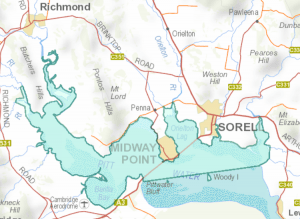The lagoon at Pittwater – Orielton is a Ramsar site which looks at over 2000 wetlands around the world. It was designated as a wetland 40 years ago this year.

Map created using theLIST – LISTmap – layer Reserves and Administrative Boundaries – then adding Reserves – Ramsar wetlands.
The wetlands have four main river/rivulet/creeks entering into the estuary area – Coal River, Orielton Rivulet, Sorell Rivulet and Iron Creek. It is an intertidal area especially for bird life including many endangered species.
When I was a teacher at Sorell, Moya Sharpe ran a project called the “Bird Sanctuary” which was down at the mouth of the Sorell Rivulet near where the sewage works are now located. Students would visit the sanctuary, check out which birds were in the area, make sure there was no rubbish to harm the birds and keep the local grasses and plants area ready for bird, insect and animal visits.
She also made sure there were interesting notice boards for visitors to read when they visited the sanctuary and the pull off areas on the causeway and around the lagoon to look at the birds on Susie Islet.
There is a Wildcare Friends of Pitt Water Orielton Lagoon group but not sure how active they are.
On a drive I took today, I could see pelicans, black swans and pied oyster catchers on the southern side of the causeway.
Readers: Have you visited the Bird Sanctuary and or the Ramsar site? What birds, animals or insects have you seen there?
While I’m in the U.S. and have never visited your area, I do love birds and sanctuaries. My brother has a home on a river that is a major migratory path and it’s such a delight to visit in Spring and Fall when the birds are making their way along it.
As a child, I spent many cool misty mornings at Orielton Lagoon with the Bird Oberservers Assioaction of Tasmania (Boat), counting and rocketnetting the migratory wader birds. We would help the experienced birders collect, identify, weigh, measure, and band the birds. In breeding season, we would paint a special dye across the breast, showing where this bird nested, so others tracking their migration to Siberia could easily see where the bird had come from.